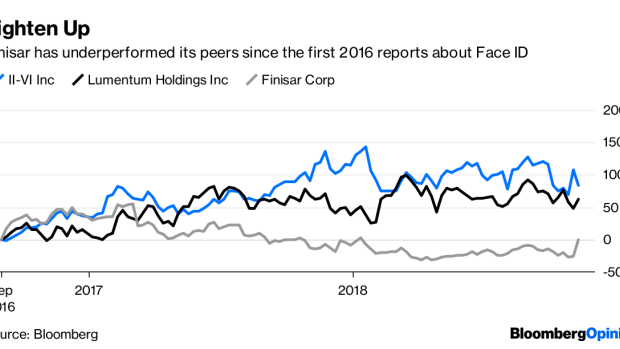Nov 9, 2018
Behind iPhone Face ID Is a Battle Over Costs
, Bloomberg News

(Bloomberg Opinion) -- The $3.2 billion acquisition of Finisar Corp. by II-VI Inc. (pronounced “two-six”) is really about one thing: how much it costs Apple Inc. to build iPhones with Face ID.
After the first whispers emerged in 2016 that Apple was considering facial recognition technology for the iPhone, the stocks of 3-D sensor makers surged inside a few months.
The story over the past 12 months has been much different for the likes of Finisar, II-VI and competitor Lumentum Holdings Inc., all of which make the vertical cavity surface-emitting lasers, or VCSELs, that Apple needs. Demand for lidar, the laser-based scanners used in autonomous cars that also use VCSELs, has yet to materialize in any significant way. Meanwhile, smartphone sales are slowing, and Apple is squeezing better prices out of suppliers to offset that. The firms’ stocks have stagnated.
The iPhone maker typically likes to have two or more suppliers for each component. It can then play them against one another, allowing it to secure cheaper prices. Austria’s AMS AG, which also supplies parts of the iPhone’s Face ID sensor array, said last month that profitability would decline in the fourth quarter. The message was clear: Apple was paying less for each component.
In addition to the three existing VCSEL suppliers, others, such as AMS and Royal Philips NV, make the components but don’t yet supply the specifications required by Apple.
That’s why Friday’s acquisition is a logical step. It gives the firms more power in their negotiations with Apple.
There are of course other advantages to the deal, which is set to close in the middle of next year. It values Finisar at about 17 times its projected 2020 earnings (its fiscal year ends in April). That looks like a decent bit of business for II-VI, which is currently trading at 14 times forward earnings. The companies expect cost synergies of $150 million within three years of closing by combining manufacturing capabilities and leaning on cross-selling to each others’ customers in smartphones and beyond.
But Apple is the biggest concern. As the 3-D sensor technology matures, the iPhone maker will most likely demand even lower prices. By reducing the number of competitors, the pendulum will swing back in II-VI’s favor. And with Apple having already committed $390 million to help Finisar build a new factory in Texas, II-VI is likely hoping to count on keeping the smartphone maker as a customer for a long time to come.
To contact the author of this story: Alex Webb at awebb25@bloomberg.net
To contact the editor responsible for this story: Daniel Niemi at dniemi1@bloomberg.net
This column does not necessarily reflect the opinion of the editorial board or Bloomberg LP and its owners.
Alex Webb is a Bloomberg Opinion columnist covering Europe's technology, media and communications industries. He previously covered Apple and other technology companies for Bloomberg News in San Francisco.
©2018 Bloomberg L.P.





